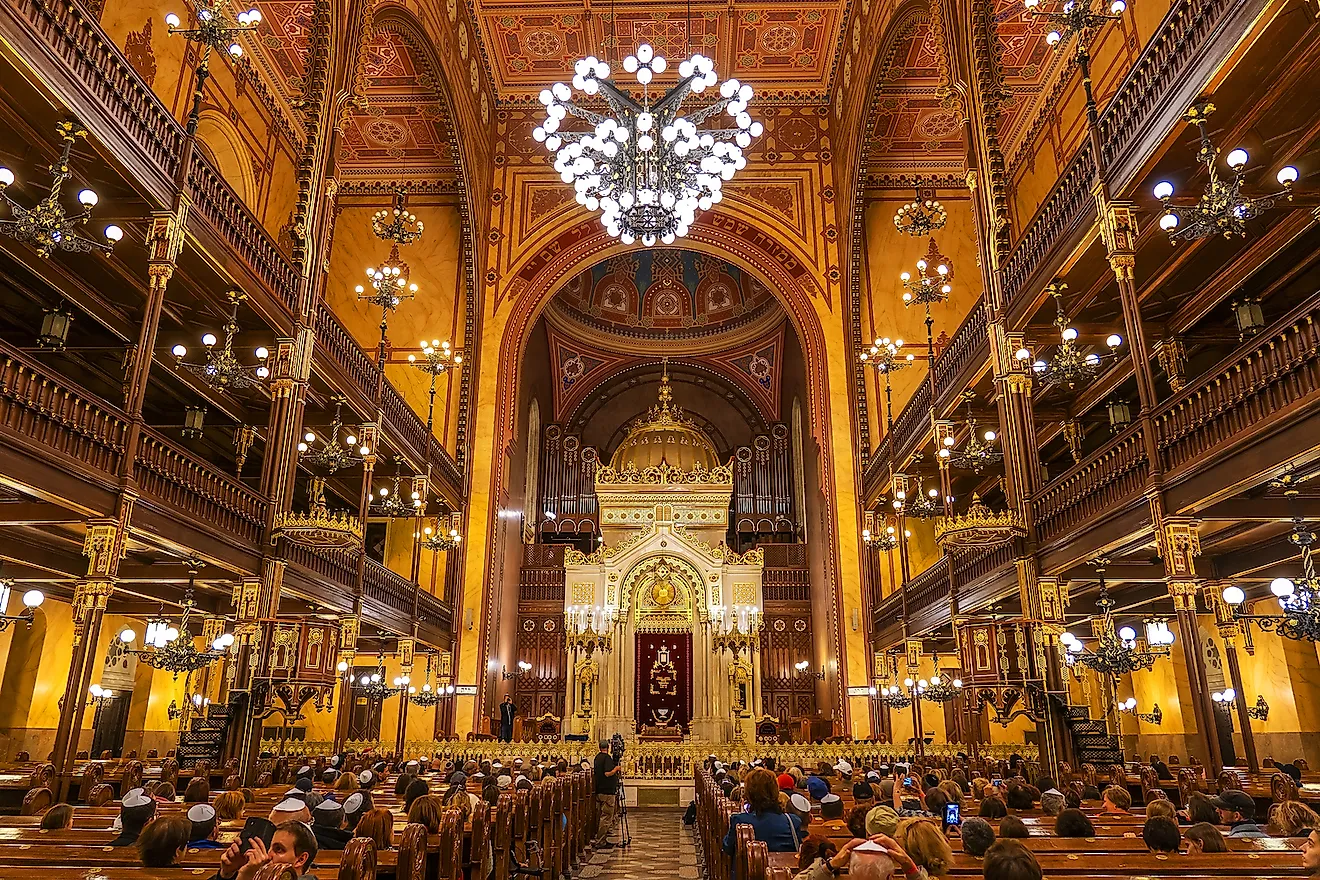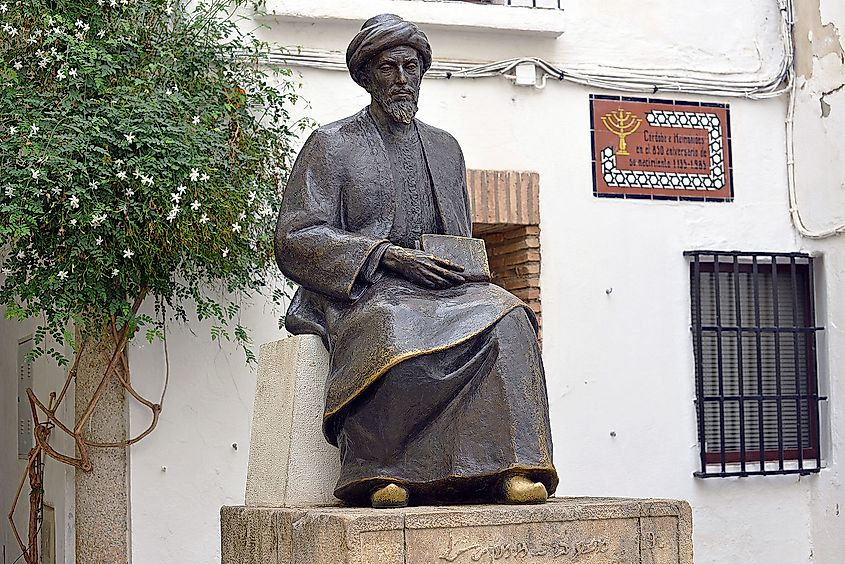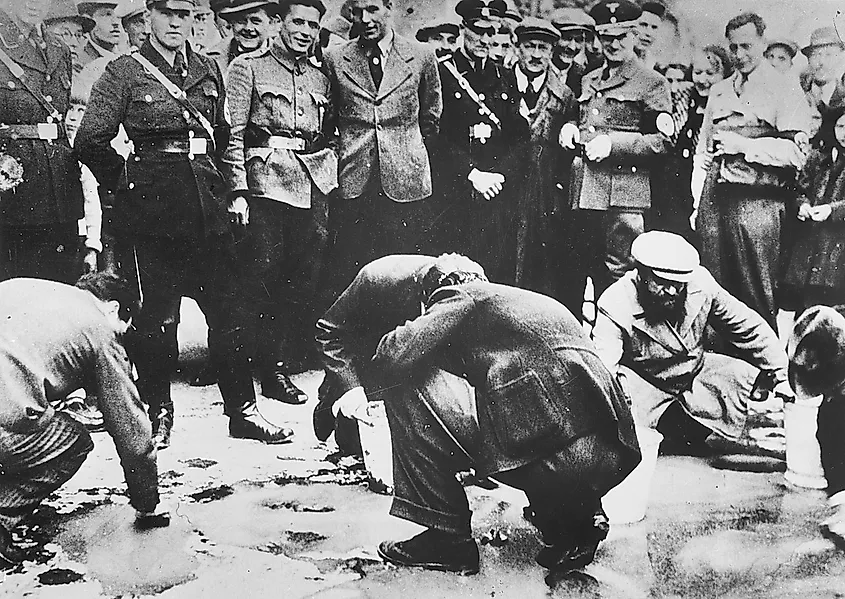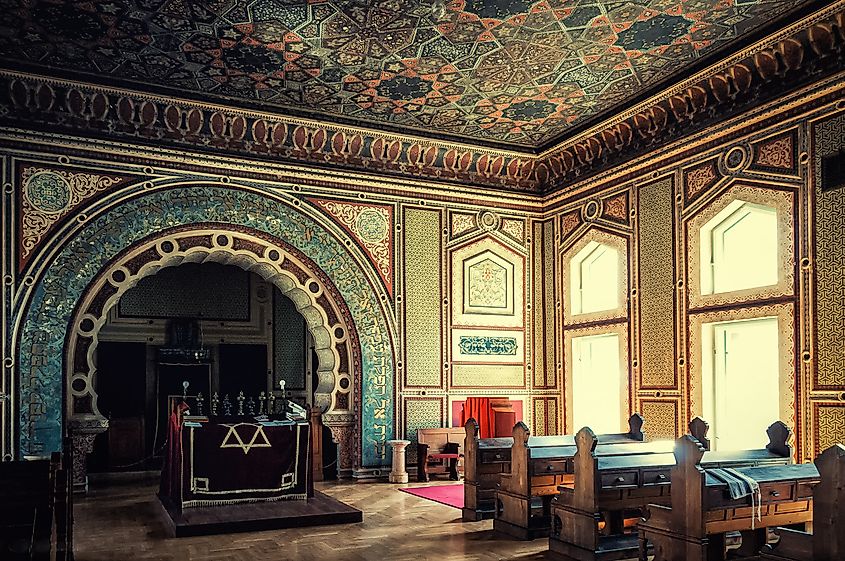European Countries With Most Jews

- Today's Jewish population in Europe numbers just over 1.3 million.
- France hosts the largest Jewish population in Europe.
- An estimated 9.5 million Jews lived in Europe before the outbreak of World War II.
- Six million Jews throughout Europe were slaughtered during the Holocaust.
- Poland, which had the largest Jewish population in Europe prior to WWII, now hosts only a few thousand Jews.
The Jewish people have had a presence in Europe for more than two thousand years, dating back to when the Roman Empire ruled much of the continent, and even beforehand. Today, just over 1.3 million Jews live in Europe. France now hosts the largest Jewish population in Europe, at 450,000.
The Jews of Europe: From the Roman Empire to World War II

A man holds up a Sephardi-style torah at the Western Wall, Jerusalem. Image credit: shlomi kakon Pikiwiki Israel/Wikimedia.org
According to Josephus Flavius, a historian who lived during Roman times, up to six million Jews lived throughout the empire. Before the first century CE, the practice of Judaism largely centered on the Holy Temple in Jerusalem. But in the year 70 CE, following an uprising in the Roman province of Judea, the Temple was destroyed. The Jews, therefore, had to adapt their faith to endure without it. Thus began the advent of rabbinic Judaism, in which Jewish communities were by led by local religious leaders known as rabbis.
After the fall of the Roman Empire, much of Europe, now largely Christian, became very hostile to the Jews, who were blamed in Christian dogma for being responsible for the death of Jesus Christ. For many centuries, Jews in Europe were relentlessly persecuted, facing a number of expulsions and massacres. They were barred from many occupations and often forced to live in confined neighborhoods known as ghettos.

Statue of Maimonides, a medieval Sephardic Jewish philosopher, in Córdoba, Spain
During Europe’s medieval period, two branches of Judaism began to develop. One branch, Ashkenazic Judaism, became predominant among Jews in central and Eastern Europe. The other branch, Sephardic Judaism, dominated southern Europe, including Spain and southern Italy. By the early 20th century, Jews in Europe were overwhelmingly Ashkenazim. Europe’s Jews also developed a new method of communicating with each other: The Yiddish language. Derived from several languages, including German, Dutch, Hebrew, and to a lesser extent, Romance and Slavic languages, Yiddish became a form of universal communication between Jews of central and Eastern Europe.

Despite the persecution that the Jewish people of Europe endured over the centuries, they managed to establish thriving communities in much of the continent, especially in central and Eastern Europe. Before World War II, some nine and a half million Jews lived in Europe. The largest European Jewish community was based in Poland, where 3.3 million Jews lived. Other large, pre-WWII Jewish communities included the Soviet Union, with more than 2.5 million Jews, Romania, with 980,000 Jews, and Germany, which had 565,000 Jews.
But the rise of Hitler and the Nazis, as well as the rise of antisemitism in general, in the 1930s prompted many Jews to leave Europe. Those didn’t leave were mostly slaughtered in the Nazis’ campaign of genocide against European Jewry, which we now call the Holocaust. When the Nazis’ reign of terror came to an end, an estimated six million of Europe’s Jews were murdered.
Europe’s Jews Today

The Sarajevo Synagogue in Sarajevo, Bosnia and Herzegovina. Image credit: Michał Huniewicz/Wikimedia.org
Jews have inhabited France since the Middle Ages, and France was the first major country in Europe to emancipate its Jewish population, according them civil and political rights, following the French Revolution. More than half of French Jews now live in Paris and its suburbs, with most of the other half living in other major cities, like Marseilles, Lyon, and Strasbourg. In the mid-20th century, most French Jews were Ashkenazim, but in the 1960s and 1970s, many Sephardic Jews in North Africa, fleeing persecution in France’s former colonies, began settling in France. As a result, today’s Jewish population in France is now 60% Sephardic. While France hosts Europe’s largest Jewish community, Jews make up a mere 0.5% of the country’s entire population.
Indeed, Jews make up very tiny percentages of their respective countries’ total populations in all cases, whether the communities are large or small, and according to the table, this trend will continue into the mid-21st century. In fact, in many European countries, Jews comprise less than 0.1% of the total population. Gibraltar, a small British dependency on the coast of Spain, has the largest percentage of Jews in relation to its total population, at 2.1%, followed by Monaco at 1.7%, and Moldova at 0.6%.
Other large Jewish communities in Europe include the United Kingdom, with 292,000 Jews, Russia, which hosts 165,000 Jews, and Germany, with 118,000 Jews. The number of Jews in Germany is small compared to the aforementioned pre-WWII Jewish population. Nevertheless, Jews have managed to make a remarkable comeback in the country, nearly tripling their numbers in the past fifteen years. The country’s Jewish population has grown in recent years due to immigration by Jews from Eastern Europe. Thus, what was once the center of European Jewry has recently lost even more of its Jewish population, and not many are left.
Even seven and a half decades after WWII ended, Jews are still a rarity in Eastern Europe. Poland, which once hosted the largest Jewish population on the continent, now hosts just 4500 Jews. The situation is very similar in other Eastern European countries. Romania, which, as previously mentioned, once had nearly a million Jews within its borders, now has only 9000. The Czech Republic and Slovakia, formerly Czechoslovakia, once hosted 357,000 Jews. But now, they collectively host just 8000. Various governments, private citizens, and charitable organizations have made efforts to restore some of the vestiges of Eastern Europe’s pre-WWII Jewish communities. Some synagogues have been restored, as have some Jewish cemeteries. Regardless of such efforts, however, fully restoring Jewish life in the countries of Europe most affected by the Holocaust will be all but impossible.

The Future of European Jewry
As the table illustrates, the percentage of Jews in each of Europe’s countries is projected to stay the same into the mid-21st century. This may, however, be a best case scenario. Over the last decade or so, antisemitism in Europe has been on a significant upswing. This, along with economic problems and political instability, have already convinced many of Europe’s remaining Jews to leave the continent and seek a better life elsewhere. In fact, each year, thousands of Jews from the former Soviet Union and France, where two of Europe’s largest Jewish communities still reside, leave Europe and immigrate to Israel. If this trend continues, many of Europe’s Jewish communities will not survive.
European Countries With Most Jews
| Rank | Country | Percentage of Jews in Population (2010) | Country | Percentage of Jews in Population (2050) |
|---|---|---|---|---|
| 1 | Gibraltar | 2.1% | Gibraltar | 2.1% |
| 2 | Monaco | 1.7% | Monaco | 1.7% |
| 3 | Moldova | 0.6% | France | 0.5% |
| 4 | France | 0.5% | Andorra | 0.3% |
| 5 | United Kingdom | 0.5% | Austria | 0.3% |
| 6 | Andorra | 0.3% | Belgium | 0.3% |
| 7 | Belgium | 0.3% | Germany | 0.3% |
| 8 | Germany | 0.3% | Moldova | 0.3% |
| 9 | San Marino | 0.3% | San Marino | 0.3% |
| 10 | Switzerland | 0.3% | United Kingdom | 0.3% |
| 11 | Austria | 0.2% | Europe (All) | 0.2% |
| 12 | Europe (All) | 0.2% | Netherlands | 0.2% |
| 13 | Netherlands | 0.2% | Sweden | 0.2% |
| 14 | Russia | 0.2% | Switzerland | 0.2% |
| 15 | Estonia | 0.1% | Liechtenstein | 0.1% |
| 16 | Hungary | 0.1% | Luxembourg | 0.1% |
| 17 | Liechtenstein | 0.1% | Spain | 0.1% |
| 18 | Luxembourg | 0.1% | Albania | < 0.1% |
| 19 | Spain | 0.1% | Belarus | < 0.1% |
| 20 | Sweden | 0.1% | Bosnia-Herzegovina | < 0.1% |
| 21 | Ukraine | 0.1% | Bulgaria | < 0.1% |
| 22 | Albania | < 0.1% | Channel Islands | < 0.1% |
| 23 | Belarus | < 0.1% | Croatia | < 0.1% |
| 24 | Bosnia-Herzegovina | < 0.1% | Czech Republic | < 0.1% |
| 25 | Bulgaria | < 0.1% | Denmark | < 0.1% |
| 26 | Channel Islands | < 0.1% | Estonia | < 0.1% |
| 27 | Croatia | < 0.1% | Faeroe Islands | < 0.1% |
| 28 | Czech Republic | < 0.1% | Finland | < 0.1% |
| 29 | Denmark | < 0.1% | Georgia | < 0.1% |
| 30 | Faeroe Islands | < 0.1% | Greece | < 0.1% |
| 31 | Finland | < 0.1% | Hungary | < 0.1% |
| 32 | Georgia | < 0.1% | Iceland | < 0.1% |
| 33 | Greece | < 0.1% | Ireland | < 0.1% |
| 34 | Iceland | < 0.1% | Isle of Man | < 0.1% |
| 35 | Ireland | < 0.1% | Italy | < 0.1% |
| 36 | Isle of Man | < 0.1% | Kosovo | < 0.1% |
| 37 | Italy | < 0.1% | Latvia | < 0.1% |
| 38 | Kosovo | < 0.1% | Lithuania | < 0.1% |
| 39 | Latvia | < 0.1% | Malta | < 0.1% |
| 40 | Lithuania | < 0.1% | Montenegro | < 0.1% |
| 41 | Malta | < 0.1% | Norway | < 0.1% |
| 42 | Montenegro | < 0.1% | Poland | < 0.1% |
| 43 | Norway | < 0.1% | Portugal | < 0.1% |
| 44 | Poland | < 0.1% | Republic of Macedonia | < 0.1% |
| 45 | Portugal | < 0.1% | Romania | < 0.1% |
| 46 | Republic of Macedonia | < 0.1% | Russia | < 0.1% |
| 47 | Romania | < 0.1% | Serbia | < 0.1% |
| 48 | Serbia | < 0.1% | Slovakia | < 0.1% |
| 49 | Slovakia | < 0.1% | Slovenia | < 0.1% |
| 50 | Slovenia | < 0.1% | Ukraine | < 0.1% |
| 51 | Vatican City | < 0.1% | Vatican City | < 0.1% |











